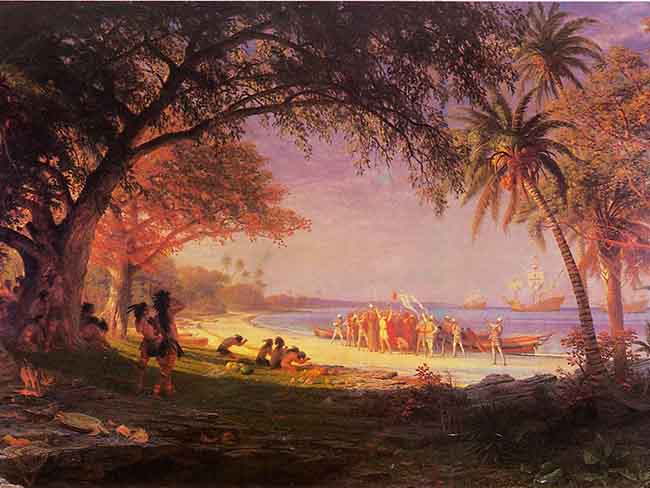Spanish documents suggest Irish arrived in America before Columbus

Did Irish settle in America before Christopher Columbis arrived?Photo by: Wikimedia Commons
While Christopher Columbus is generally credited with having discovered America in 1492, a 1521 Spanish report provides inklings of evidence that there were, in fact, Irish people settled in America prior to Columbus’ journey.
“Researchers feel certain that there was a colony of Irish folk living in what is now South Carolina, when Christopher Columbus “thought” he had discovered the New World,” writes Richard Thornton for The Examiner.
In 1520, Peter Martyr d’Anghiera, a historian and professor, was appointed by Charles V to be chronicler for the new Council of the Indies.
Though Martyr died in 1526, his report, founded on several weeks of interviews, was published posthumously in a book named «De Orbe Novo» (About the New World). The book has been published and translated numerous times in the centuries since then. The passages concerning the land that would become Georgia and the Carolinas were always included, but generally ignored, says Thornton.
While interviewing Spanish colonists, Martyr took note of their vicious treatment of Chicora Indians. However, he also included in his report that the Spanish colonists had a very good relationship with another nearby colony, which Martyr reported to be named Duhare.
Physically, the people of Duhare appeared to be European according to the Spanish colonists in the area. The people of Duhare had red to brown hair, tan skin and gray eyes, and were noticeably taller than the Spanish. According to Spanish accounts, the people of Duhare were Caucasian, though their houses and pottery were similar to those of American Indians.
The king of Duhare was said to be named Datha and was described by the Spanish as being a giant, even when compared to his peers. He had five children and a wife as tall as him. Datha had brightly colored paint or tattoos on his skin that seemed to distinguish him from the commoners.
Despite Martyr’s report that included the apparently unique tribe of the Duhare, the believed predecessors of the Creek Indian tribe, more recent scholars are wary of the possibility of a Caucasian tribe at that time in America.
“In 1922 the Smithsonian Institute published, “Early History of the Creek Indians and Their Neighbors” by renowned ethnologist, John W. Swanton. It included much of Martyr’s passages on Duhare, but was prefaced with contemptuous remarks by Swanton that the story couldn’t be true and that the Duhare were probably a Siouan tribe,” explains Thornton.
However, later in 2006, People of One Fire, a nationwide team of Native American scholars, primarily of Creek Indian heritage, began a comprehensive research program to obtain more accurate and detailed knowledge of North America’s pre-European history.
As part of their research, they began to attempt to translate every single Native American word that was translated by the Spanish. While many of those words were easily translated by modern Creek, Alabama, Koasati or Choctaw dictionaries, the words associated with the province of Duhare defied translation until 2011.
Researchers began to investigate the similarity of Irish rock carvings to those in the state of South Carolina. One member of the People of One Fire team came across an ancient Irish lullaby entitled “Bainne nam fiadh;” On milk of deer I was reared. On milk of deer I was nurtured. On milk of deer beneath the ridge of storms on crest of hill and mountain.”
The lullaby has particular significance as the deer were a prominent resource for Duhare people. According to Spanish sources, the Duhare maintained large herds of domesticated deer and made cheese from deer milk. The excess male deer population was fattened with corn for butchering.
The deer stayed in corrals within the villages at night, but grazed in herds in the day time, accompanied by “deer-herders” and herd dogs. Neighboring peoples knew not to hunt them.
The Duhare words, recorded by the Spanish, were able to be translated using Gaelic dictionaries. Duhare, in fact, was found to be translated to either “place of the Clan Hare,” or if the Duhare came from west of the Shannon River, it meant, “du’hEir,” place of the Irish.
Further solidifying the Irish roots in Duhare, it was found that Datha, the name of the leader of Duhare, was a standard Medieval Irish Gaelic word that means “painted.” Datha of Duhare was remembered for being tattooed or painted, as if to separate himself from the commoners – a tradition among Celts.
Also in 2011, the mystery of the Reinhardt Boulder – an ancient and mysterious carved rock that was found years ago on the Cline farm in the Hickory Log area of Cherokee County in Georgia near the Etowah River – was put to rest after striking similarities between its carvings and rock carvings that originated around the Atlantic Coast of Ireland were identified.
“There is a boulder on the Dingle Peninsula of County Kerry that has the same glyphs (carvings) as the Reinhardt boulder and is approximately the same size. The Reinhardt Boulders’ concentric circles are a common theme of petroglyphic boulders all along the western Irish coast. However, the answer to the riddle of the Reinhardt Petroglyph has created many more questions about North America’s history before Christopher Columbus’s voyage,” writes Thornton in a separate article.
Thornton himself asserts that researchers believe that the Duhare tribe was established prior to Columbus “discovering” America in 1492. However, he freely admits that historians and researchers do not know how, when or why the Irish arrived in present-day America.
While there is overwhelming evidence of Irish influence in what is now the area of South Carolina and Georgia, Thornton himself is careful to note that until solid DNA evidence is produced, it is hard to definitively link pre-Columbus America with Ireland.
Originally published in 2011.
from IrishCentral
 Блог Ireland.RU
Блог Ireland.RU
Добавить комментарий
Для отправки комментария вам необходимо авторизоваться.